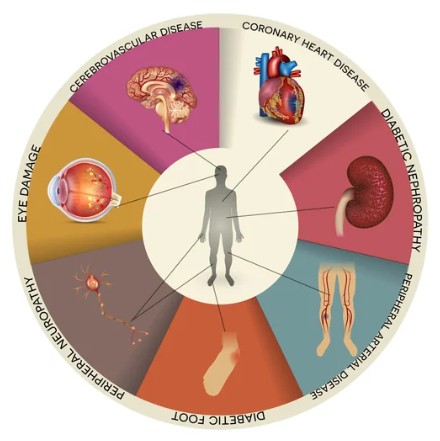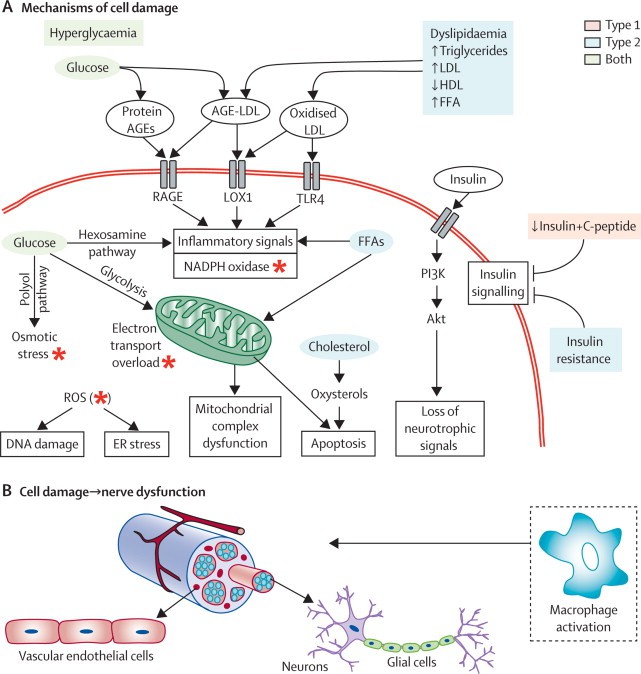Diabetic Peripheral Neuropathy
About Diabetic Peripheral Neuropathy and Related Molecules

Diabetic Peripheral Neuropathy (DPN) is a common complication of diabetes mellitus, affecting approximately 50% of diabetic patients. It is a type of nerve damage that occurs due to chronic high blood sugar levels, leading to damage to the peripheral nerves in various parts of the body. DPN primarily affects the nerves in the feet and legs, but it can also affect the hands and arms. The symptoms can vary from mild to severe and may include numbness, tingling, pain, and weakness in the affected areas. These symptoms can significantly impact the quality of life and daily activities of individuals with DPN.
The exact molecular mechanisms underlying DPN are not yet fully understood. However, several molecular factors have been identified to play a role in the development and progression of the condition. These include:
- Oxidative stress: High blood sugar levels can lead to the production of reactive oxygen species (ROS), causing oxidative stress. This oxidative stress can damage the nerves and impair their function.
- Advanced glycation end products (AGEs): In diabetes, excess glucose can react with proteins in the body, forming AGEs. These AGEs can accumulate in the nerves and blood vessels, leading to inflammation and nerve damage.
- Polyol pathway: In diabetes, excess glucose can be converted into sorbitol through the polyol pathway. Sorbitol accumulation in nerve cells can cause osmotic stress and disrupt normal nerve function.
- Neuroinflammation: Chronic inflammation in the nerves is believed to contribute to the development and progression of DPN. Inflammatory mediators such as cytokines and chemokines can activate immune cells and damage nerves.
- Nerve growth factor (NGF) deficiency: Diabetic patients often have reduced levels of NGF, a protein that promotes nerve growth and repair. Without adequate NGF, the regenerative capacity of nerves is compromised, leading to nerve damage.
Understanding the molecular mechanisms underlying DPN is crucial for developing targeted therapies to prevent or treat the disease.
Biological Functions of Diabetic Peripheral Neuropathy-Related Molecules
Diabetic peripheral neuropathy is a condition that affects the nerves in the extremities, such as the legs and feet, due to prolonged uncontrolled diabetes. This condition can lead to various molecular changes in the body that contribute to the development and progression of nerve damage. Some of the main molecules involved in diabetic peripheral neuropathy and their biological functions are:
Advanced Glycation End Products (AGEs): AGEs are formed when glucose molecules attach to proteins in a process called glycation. In diabetes, high blood glucose levels can lead to increased production of AGEs. These molecules can accumulate in nerve tissues and alter their structure and function, leading to nerve damage.
Oxidative Stress: Diabetes can cause an imbalance between the production of reactive oxygen species (ROS) and the body's ability to neutralize them. This leads to oxidative stress, which can damage nerve cells and impair their function. Antioxidant molecules, such as glutathione and superoxide dismutase, are essential in preventing and repairing oxidative damage.
Pro-inflammatory Cytokines: Inflammation plays a crucial role in the development and progression of diabetic peripheral neuropathy. Elevated levels of pro-inflammatory cytokines, such as tumor necrosis factor-alpha (TNF-α) and interleukin-6 (IL-6), are found in individuals with diabetic neuropathy. These molecules contribute to nerve damage by promoting inflammation and causing cellular dysfunction.
Nerve Growth Factor (NGF): NGF is a protein that plays a vital role in the growth, development, and maintenance of nerve cells. In diabetic peripheral neuropathy, reduced levels of NGF have been observed, which can lead to impaired nerve repair and regeneration. Insufficient NGF levels contribute to the loss of nerve fibers and the development of neuropathic pain.
Matrix Metalloproteinases (MMPs): MMPs are enzymes involved in tissue remodeling and repair. In diabetes, MMPs can become overactive and contribute to tissue damage, including damage to nerve tissue. This can further exacerbate the symptoms of diabetic peripheral neuropathy.
Cytokines: Cytokines are signaling molecules produced by various cells in the body, including immune cells. In diabetes, certain cytokines, such as tumor necrosis factor-alpha (TNF-alpha) and interleukin-1 beta (IL-1β), can be upregulated. These cytokines can contribute to inflammation and oxidative stress, further damaging nerve tissue and worsening symptoms of diabetic peripheral neuropathy.
Neurotrophins: Neurotrophins are a family of proteins that support the growth and survival of neurons. In diabetic peripheral neuropathy, the levels of certain neurotrophins, such as brain-derived neurotrophic factor (BDNF), can be reduced. This can lead to impaired nerve function and contribute to the development and progression of neuropathy.
 Fig.2 Mechanisms of diabetic neuropathy. (Callaghan BC, et al., 2012)
Fig.2 Mechanisms of diabetic neuropathy. (Callaghan BC, et al., 2012)
Implications for Studying Diabetic Peripheral Neuropathy-related Molecular
Molecular research on DPN aims to understand the underlying mechanisms and identify potential therapeutic targets. Here are the significance and application areas of DPN-related molecular research:
Mechanistic Insights: Molecular research helps unravel the intricate pathways involved in the development and progression of DPN. This knowledge is essential for better understanding the cellular and molecular changes that occur in the peripheral nerves. It can aid in developing targeted therapies to either delay or prevent the onset of DPN.
Biomarker Discovery: Identification of molecular biomarkers specific to DPN can facilitate early detection and diagnosis. Researchers are searching for blood-based biomarkers, such as cytokines, growth factors, and microRNAs, that could reflect the neurodegenerative processes associated with DPN. These biomarkers can be used to monitor disease progression, assess treatment efficacy, and potentially predict the risk of developing DPN in individuals with diabetes.
Drug Targets and Therapy Development: Molecular research provides insights into various molecular pathways that contribute to DPN pathogenesis. This knowledge allows researchers to identify potential drug targets. For example, understanding the role of oxidative stress, inflammation, and advanced glycation end products (AGEs) in DPN may guide the development of therapeutic interventions that can specifically target these processes.
Available Resources for Diabetic Peripheral Neuropathy
Creative BioMart offers a broad range of products and services to support research into diabetic peripheral neuropathy and related molecules. Our offerings include recombinant proteins, cell and tissue lysates, protein pre-coupled beads, and others. We also offer custom services to meet specific research needs. Additionally, we provide resource support, including pathways, protein functions, interacting proteins, and relevant articles, to enhance understanding and study of these molecules. Explore the diabetic peripheral neuropathy-related molecules below for more comprehensive resources.
We are dedicated to providing you with high-quality research tools and services to help you achieve successful scientific outcomes. If you have any further questions or require custom services, please feel free to contact us at any time.
Reference:
- Callaghan BC, Cheng HT, Stables CL, Smith AL, Feldman EL. Diabetic neuropathy: clinical manifestations and current treatments. Lancet Neurol. 2012;11(6):521-534.


